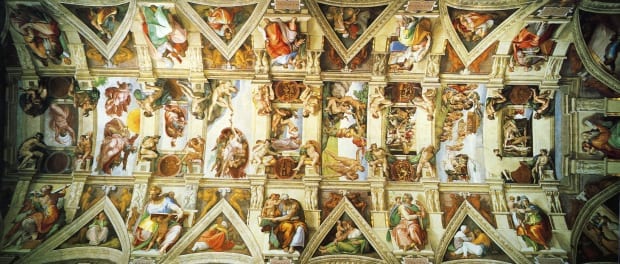Ella Khalek looks at five influential art movements, from 500 BC to 1600 AD, to explore the nature of beauty and how we should define it.
From the current big booty craze to selfie-stick mania, we are well aware of the ever-changing trends of our society. It is inevitable that people will always be looking for a ‘new thing’, to try and break the monotony of their lives. The art world is just the same, and indeed I would argue that the changing perception of what is considered ‘beautiful’ has driven the various artistic movements over the past 2000 years.
To begin, lets return to Ancient Greece. It seems the Greeks managed to avoid the subjective question of what is beautiful, by involving maths – not something generally associated with beauty! Proportional relationships in figures, following on from the concept of symmetria was of utmost importance in Greek art. The idea of Golden Section – which was Pythagoras’ idea of the divine proportion – can be seen to an extent as a mathematical formula to define beauty. The ratio; 1:√5 is that of an irrational number – thought to be a manifestation of the gods, as it was beyond the reach of mortal men. This proportion was considered to be the most pleasing to the eye, and thus many works of art were created with this in mind. One famous example is the Parthenon at Athens.
While Greek artists strived for idealisation and perfection, the Romans sought to replicate figures with a greater sense of realism. This idea is likely to have derived from the Roman death masks, which were wax moulds taken of the dead and kept by relatives to remember them.
Next we reach Byzantine art – the art of Christian symbolism. There was no concept of spacial representation or proportion – the most important figure would be the largest – and thus the realism of Roman art was abandoned. The paintings were supposed to look two-dimensional and so there was no perspective or shadow. This was to ensure that life was not confused with art, as art was supposed to convey the wonder of the divine world. These ideas continued into Gothic art, which focused on illustrating ideas and serving God’s purpose; art was not supposed to be admired in itself.

The Renaissance – perhaps the most admired of Western art movements – has been split into the categories of Early, Northern, Venetian and High and spans around 200 years. As the name suggests, this was the rebirth of classical antiquity and was revolutionary for the art world. The concept was emulatio; artists wanted to take inspiration from the past but make something new. The ideas that they particularly looked to from the classical past were Greek idealism and Roman realism. They also started to look at the concept of man himself: anthropocentric ideas became centre of study and were placed in space with dignity and gravitas. Painting began to have depth, creating an illusion of reality. This was intended to aid in the understanding of Biblical stories – as painting was the Bible of the illiterate – and endeavoured to encourage people to emulate how Saints had lived. The High Renaissance saw the culmination of compositional clarity and structural harmony and it was once these ambitions had been achieved that artists decided to break them.
Mannerism is perhaps one of the most complicated artistic movements, as it required a knowledge of the High Renaissance ideals and a subsequent rejection of them. Mannerism is equated with a concentration on the nude, often in bizarre and exaggerated poses and lacking the gravitas of the High Renaissance. It is often difficult to understand the true meaning of the art as the subject is either obscure or placed in the background. It involved extremes of perspective and distorted proportion; often the figures are compared to flames in their elongation. Renaissance artists painted from life, but mannerists took inspiration from other artwork and distorted it.

The question of what is considered beautiful is one of the oldest and most controversial facing the world of art. Often the question is explored in terms of what is aesthetically pleasing to the eye of the viewer, but the changing and subjective nature of this idea leaves it with an indefinite resolve. I would argue that we should be considering an artist’s ability to express the stylistic values of the contemporary movement when we assess the beauty of artwork. Only through that can we define – for ourselves – what beauty should be.
Words by Ella Khalek
